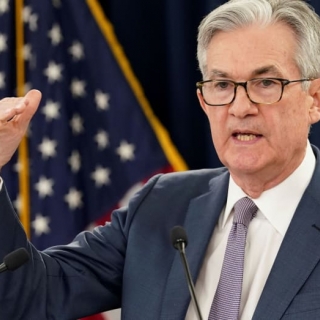


Fed Chairman Jerome Powell assessed that the US economy remains resilient: the job market is near its maximum, inflation has fallen well from its peak, but the balance of risks is shifting. In his speech on "Monetary Policy and the Fed's Framework Review" in Jackson Hole, he stated that current policy remains restrictive and that changes in the outlook could require policy adjustments.
Powell outlined new challenges this year: higher tariffs in many trading partners, a slowdown in immigration that is depressing labor force growth, and changes in fiscal and regulatory policies. He emphasized that monetary policy can stabilize the economic cycle but does little to change structural factors.
The job market is described as being in a "strange equilibrium": payroll growth has slowed sharply in the last three months (averaging 35,000), unemployment remains low at 4.2%, and other indicators (quits, layoffs, and the vacancy rate) have weakened moderately. These conditions increase the risk of a job downturn if things worsen, layoffs could rise rapidly.
First-half GDP growth fell significantly to 1.2% (vs. 2.5% in 2024), primarily due to slowing consumption. Some of the weakening reflects a slowdown in the supply/potential output side, not simply a demand cycle.
Tariff-driven inflation: headline PCE 2.6% yoy, core PCE 2.9%. Goods prices rebounded by +1.1% yoy; housing inflation fell, while non-residential services remained above a consistent pace of 2%. Powell's base case: the impact of tariffs is one-off (gradual), but he will not allow temporary price increases to become a persistent inflation problem.
Policy implications: Inflation risks are tilted to the upside, while employment risks are tilted to the downside a challenging situation for a dual mandate. Interest rates are now 100 bps closer to neutral than a year ago, so the Fed will proceed cautiously and data-dependently. With restrictive policy, adjustments may be warranted if the outlook and risks point in that direction.
Key points:
Powell also released a revised policy framework: removing the focus on ELB as a key feature, returning to flexible inflation targeting (ending the "makeup" strategy), reaffirming the importance of anchoring inflation expectations at 2%, and clarifying that employment can exceed the real-time "maximum" without automatically threatening price stability but preemptive action remains possible if inflation risks rise. The Fed will publicly review this framework approximately every five years. (ayu)
Source: Newsmaker.id
US Federal Reserve (Fed) Chairman Jerome Powell is scheduled to deliver a speech titled "Economic Outlook and Framework Review" at the annual Jackson Hole Economic Symposium on Friday at 14:00 GMT. M...
Fed Chair Powell's looming speech at the annual Jackson Hole symposium will be the next catalyst for the U.S. dollar moves, says Joe Capurso, an economist at Commonwealth Bank of Australia. Still, don...
Bets that the U.S. Federal Reserve will cut interest rates in September have dropped significantly over the past week, as markets prepare for Fed Chair Jerome Powell's speech at Jackson Hole on Friday...
The Fed held rates steady at 4.25%–4.50% for a fifth straight meeting, as expected, but two governors dissented in favor of a cut the first such dual dissent since 1993. Policymakers observed that, w...
According to the FOMC Minutes, the two Federal Reserve policymakers who disagreed with the central bank's decision to keep interest rates the same last month were not joined by other policymakers in c...
Gold strengthened 0.6% to US$3,359/oz in the US session on Friday (August 22nd), as the dollar weakened after Fed Chairman Jerome Powell opened the door to a September interest rate cut. Sentiment turned positive for the precious metal as the...
Fed Chairman Jerome Powell assessed that the US economy remains resilient: the job market is near its maximum, inflation has fallen well from its peak, but the balance of risks is shifting. In his speech on "Monetary Policy and the Fed's Framework...
US stocks rose slightly on Friday after a decline led by the technology sector this week as the market awaited Federal Reserve Chairman Powell's speech at the Jackson Hole Economic Symposium. The S&P 500 and Dow Jones Industrial Average rose...
 The Fed held rates steady at 4.25%–4.50% for a fifth straight meeting, as expected, but two governors dissented in favor of a cut the first such...
The Fed held rates steady at 4.25%–4.50% for a fifth straight meeting, as expected, but two governors dissented in favor of a cut the first such...
 Bets that the U.S. Federal Reserve will cut interest rates in September have dropped significantly over the past week, as markets prepare for Fed...
Bets that the U.S. Federal Reserve will cut interest rates in September have dropped significantly over the past week, as markets prepare for Fed...
 US manufacturing activity in August surged to 53.3 (above 50 = expansion), the highest since May 2022. Surging demand boosted production and a...
US manufacturing activity in August surged to 53.3 (above 50 = expansion), the highest since May 2022. Surging demand boosted production and a...
